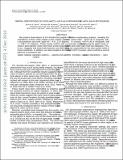| dc.contributor.author | Winn, Joshua Nathan | |
| dc.contributor.author | Howard, Andrew W. | |
| dc.contributor.author | Johnson, John Asher | |
| dc.contributor.author | Marcy, Geoffrey W. | |
| dc.contributor.author | Isaacson, Howard | |
| dc.contributor.author | Shporer, Avi | |
| dc.contributor.author | Bakos, Gaspar A. | |
| dc.contributor.author | Hartman, Joel D. | |
| dc.contributor.author | Holman, Matthew J. | |
| dc.contributor.author | Albrecht, Simon H. | |
| dc.contributor.author | Crepp, Justin R. | |
| dc.contributor.author | Morton, Timothy D. | |
| dc.date.accessioned | 2012-08-10T19:15:53Z | |
| dc.date.available | 2012-08-10T19:15:53Z | |
| dc.date.issued | 2011-02 | |
| dc.date.submitted | 2010-12 | |
| dc.identifier.issn | 0004-6256 | |
| dc.identifier.issn | 1538-3881 | |
| dc.identifier.uri | http://hdl.handle.net/1721.1/72100 | |
| dc.description.abstract | We present observations of the Rossiter-McLaughlin effect for two exoplanetary systems, revealing the orientations of their orbits relative to the rotation axes of their parent stars. HAT-P-4b is prograde, with a sky-projected spin-orbit angle of λ = –4.9 ± 11.9 deg. In contrast, HAT-P-14b is retrograde, with λ = 189.1 ± 5.1 deg. These results conform with a previously noted pattern among the stellar hosts of close-in giant planets: hotter stars have a wide range of obliquities and cooler stars have low obliquities. This, in turn, suggests that three-body dynamics and tidal dissipation are responsible for the short-period orbits of many exoplanets. In addition, our data revealed a third body in the HAT-P-4 system, which could be a second planet or a companion star. | en_US |
| dc.description.sponsorship | United States. National Aeronautics and Space Administration (Origins program grant NNX09AD36G) | en_US |
| dc.description.sponsorship | United States. National Aeronautics and Space Administration (award NNX09AB33G) | en_US |
| dc.language.iso | en_US | |
| dc.publisher | IOP Publishing | en_US |
| dc.relation.isversionof | http://dx.doi.org/10.1088/0004-6256/141/2/63 | en_US |
| dc.rights | Creative Commons Attribution-Noncommercial-Share Alike 3.0 | en_US |
| dc.rights.uri | http://creativecommons.org/licenses/by-nc-sa/3.0/ | en_US |
| dc.source | Prof. Canizares via Mat Willmott | en_US |
| dc.title | Orbital Orientations of Exoplanets: Hat-p-4b is Prograde and Hat-p-14b is Retrograde | en_US |
| dc.type | Article | en_US |
| dc.identifier.citation | Winn, Joshua N. et al. “ORBITAL ORIENTATIONS OF EXOPLANETS: HAT-P-4b IS PROGRADE AND HAT-P-14b IS RETROGRADE.” The Astronomical Journal 141.2 (2011): 63. | en_US |
| dc.contributor.department | Massachusetts Institute of Technology. Department of Physics | en_US |
| dc.contributor.department | MIT Kavli Institute for Astrophysics and Space Research | en_US |
| dc.contributor.approver | Winn, Joshua Nathan | |
| dc.contributor.mitauthor | Winn, Joshua Nathan | |
| dc.contributor.mitauthor | Albrecht, Simon H. | |
| dc.relation.journal | Astronomical Journal | en_US |
| dc.eprint.version | Author's final manuscript | en_US |
| dc.type.uri | http://purl.org/eprint/type/JournalArticle | en_US |
| eprint.status | http://purl.org/eprint/status/PeerReviewed | en_US |
| dspace.orderedauthors | Winn, Joshua N.; Howard, Andrew W.; Johnson, John Asher; Marcy, Geoffrey W.; Isaacson, Howard; Shporer, Avi; Bakos, Gáspár Á.; Hartman, Joel D.; Holman, Matthew J.; Albrecht, Simon; Crepp, Justin R.; Morton, Timothy D. | en |
| dc.identifier.orcid | https://orcid.org/0000-0002-4265-047X | |
| mit.license | OPEN_ACCESS_POLICY | en_US |
| mit.metadata.status | Complete | |
